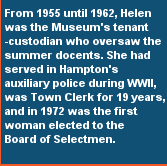
1950s

|

|

|

 For the Association, the so-called 'Happy' years of the 1950s were a time to plan for expansion and preservation. As early as 1951, members talked of adding space to the tiny Historical Room with its burgeoning collection of historical items. When Army engineer Wilbar Hoxie was elected president in 1957, his first project was to design the addition we now call the '60s Wing. Through the efforts of Judge John Perkins (President 1959-1961), the Association received its tax deductible status to encourage financial gifts.
The Association had the opportunity to acquire Hampton's only remaining 19th century one-room school house. A committee originally declined to recommend the $300 purchase, but by 1953 the small building had been moved from Lafayette Road to the Museum grounds and the work of restoration started.
There was interest in preserving several historical sites: Hampton's Rune Stone (Thorvald's Rock), Bound Rock, and the Deacon Tuck Gristmill on lower High Street. The Association would not acquire Thorvald's Rock until 1989, and the Town bought Bound Rock in 1956 and the Gristmill in 1959.
There was growing interest in protecting natural resources. Activist Ruth Stimson gave talks to raise conservation awareness and Association VP Sam Towle encouraged preservation of the marsh as a bird sanctuary. Adeline Marston spoke of roadside beautification and preservation of old homes.
For the Association, the so-called 'Happy' years of the 1950s were a time to plan for expansion and preservation. As early as 1951, members talked of adding space to the tiny Historical Room with its burgeoning collection of historical items. When Army engineer Wilbar Hoxie was elected president in 1957, his first project was to design the addition we now call the '60s Wing. Through the efforts of Judge John Perkins (President 1959-1961), the Association received its tax deductible status to encourage financial gifts.
The Association had the opportunity to acquire Hampton's only remaining 19th century one-room school house. A committee originally declined to recommend the $300 purchase, but by 1953 the small building had been moved from Lafayette Road to the Museum grounds and the work of restoration started.
There was interest in preserving several historical sites: Hampton's Rune Stone (Thorvald's Rock), Bound Rock, and the Deacon Tuck Gristmill on lower High Street. The Association would not acquire Thorvald's Rock until 1989, and the Town bought Bound Rock in 1956 and the Gristmill in 1959.
There was growing interest in protecting natural resources. Activist Ruth Stimson gave talks to raise conservation awareness and Association VP Sam Towle encouraged preservation of the marsh as a bird sanctuary. Adeline Marston spoke of roadside beautification and preservation of old homes.
 In 1950 the members voted to meet every three months to maintain a level of interest in the Association, which the recording secretaries began to refer to as the 'Society.' In the first half of the decade meetings were opened with prayer and a salute to the flag. By the end of the decade only the salute remained on record. The tradition of a summer outdoor meeting was continued, and the annual meetings in October were held at Tuck Hall. The first evening annual meeting was held in 1953. The Historians were Esther Davis Proctor (1950-1954), Ruth Pratt (1954-1960), and Allan Towle (1957-1960). The Association ended the decade with $3,621.15 in the Treasury.
In 1950 the members voted to meet every three months to maintain a level of interest in the Association, which the recording secretaries began to refer to as the 'Society.' In the first half of the decade meetings were opened with prayer and a salute to the flag. By the end of the decade only the salute remained on record. The tradition of a summer outdoor meeting was continued, and the annual meetings in October were held at Tuck Hall. The first evening annual meeting was held in 1953. The Historians were Esther Davis Proctor (1950-1954), Ruth Pratt (1954-1960), and Allan Towle (1957-1960). The Association ended the decade with $3,621.15 in the Treasury.

 Infantile paralysis, or polio, was one of the most feared diseases in the first half of the 20th century. Highly infectious, it struck mainly children and could leave its victims crippled for life. In 1935 Hampton school nurse Elizabeth Hills Hay, who went on to serve in WWII, issued a warning about a recent epidemic. Then in 1946 a visitor to Hampton sent a postcard that read 'We don't go to the beach much. Too much polio around in places. None in town yet.'
In the early 1950s a massive inoculation campaign using Jonas Salk's new polio vaccine was put into effect. Reagents used to develop the vaccine were made by the Fisher Scientific Company (the forerunner of Fisher Scientific International with main offices in Hampton, 1991-2006).
Hampton school children began receiving injections of Salk vaccine in the spring of 1955, with oral vaccines available in 1961. Since those early years children have been routinely inoculated against polio, essentially eradicating the disease from the United States.
Infantile paralysis, or polio, was one of the most feared diseases in the first half of the 20th century. Highly infectious, it struck mainly children and could leave its victims crippled for life. In 1935 Hampton school nurse Elizabeth Hills Hay, who went on to serve in WWII, issued a warning about a recent epidemic. Then in 1946 a visitor to Hampton sent a postcard that read 'We don't go to the beach much. Too much polio around in places. None in town yet.'
In the early 1950s a massive inoculation campaign using Jonas Salk's new polio vaccine was put into effect. Reagents used to develop the vaccine were made by the Fisher Scientific Company (the forerunner of Fisher Scientific International with main offices in Hampton, 1991-2006).
Hampton school children began receiving injections of Salk vaccine in the spring of 1955, with oral vaccines available in 1961. Since those early years children have been routinely inoculated against polio, essentially eradicating the disease from the United States.